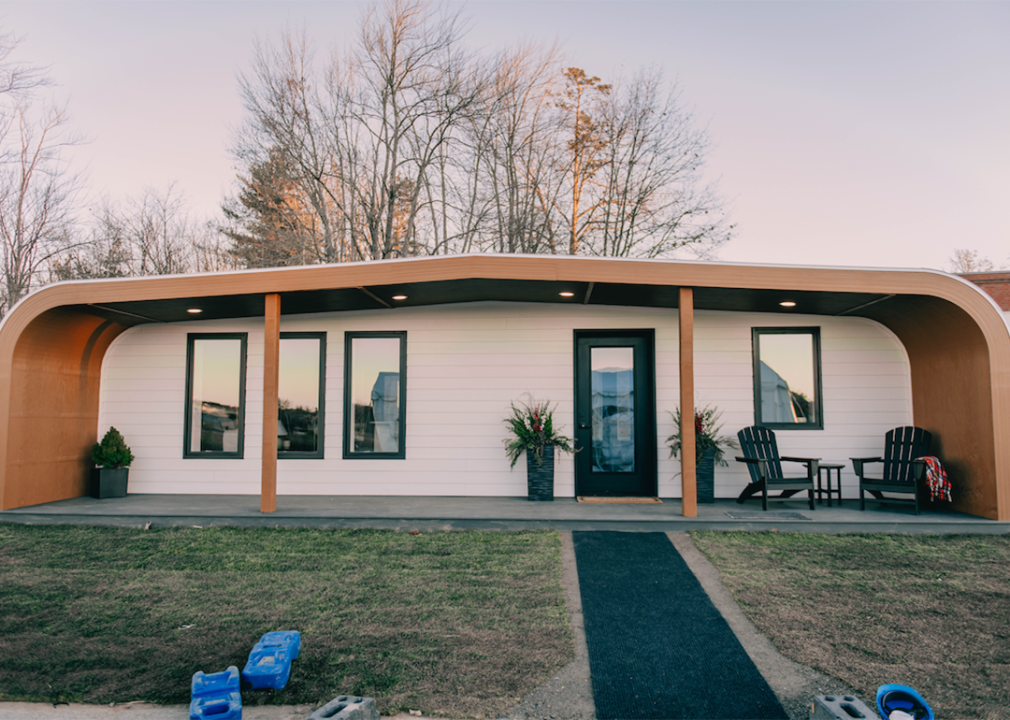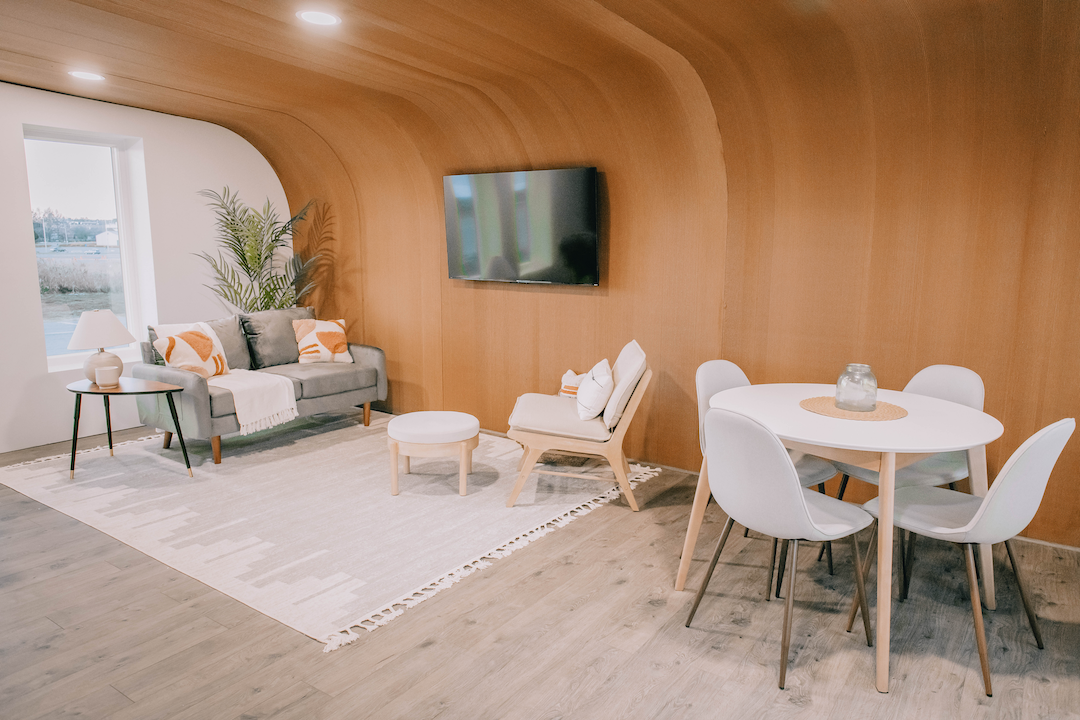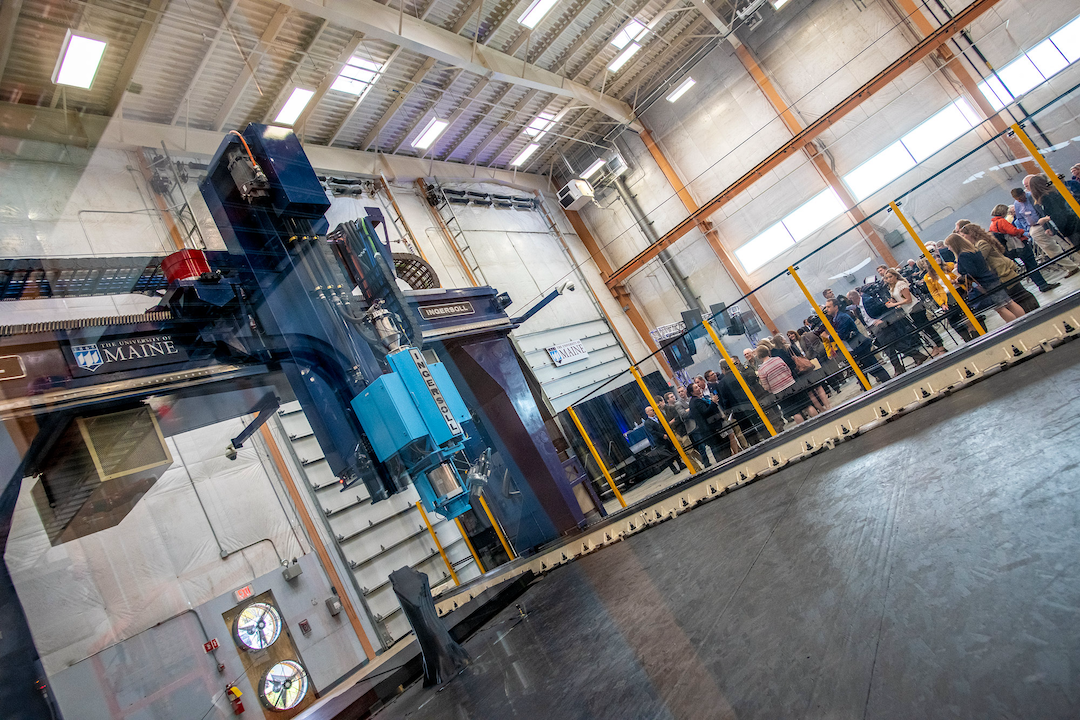The house of the future will be recyclable: Introducing the first affordable, bio-based 3D-printed house

Courtesy of the University of Maine Advanced Structures and Composites Center
The house of the future will be recyclable: Introducing the first affordable, bio-based 3D-printed house
600-square-foot, 3D-printed, bio-based houses crafted from materials like wood fibers and bioresins
When you imagine a 3D-printed home, you probably picture a boxy concrete structure. As 3D printing’s popularity has grown in the construction industry — thanks to its efficiency when it comes to time, energy and cost — carbon-intensive concrete has become the go-to building material.
But a project in Maine has set its sights on something different: a neighborhood of 600-square-foot, 3D-printed, bio-based houses crafted from materials like wood fibers and bioresins. The aim: a complex of 100-percent recyclable buildings that will provide homes to those experiencing houselessness.
In late 2022, an initiative between the University of Maine and local nonprofit Penquis unveiled its prototype — BioHome3D, the first 100-percent recyclable house. Now, the pioneering project is working toward completing its first livable housing complex. It will be fully bio-based, meaning all materials will be derived from living organisms such as plants and other renewable agricultural, marine and forestry materials. Reasons to Be Cheerful takes a closer look at the science and innovation behind the 3D printer creating these innovative buildings.
![]()

Courtesy of the University of Maine Advanced Structures and Composites Center
Bio-based materials are designed to produce homes at scale
As the materials are all 100-percent recyclable, so become the buildings. The materials are also all renewable. And thanks to its natural composition, the home acts as a carbon sink, sequestering 46 tons of carbon dioxide per 600-square-foot unit.
The materials for this project will mainly come from wood left over by local mills. “The wood fiber material that’s used in the mix is essentially waste wood here in Maine,” says Jason Bird, director of housing development for Penquis. Bird is referring to what’s known as wood residuals: materials that, he explains, “pulp mills or other sawmills either landfill, discard or set off to the side and rot.”
According to the University of Maine, the state’s sawmills produce nearly one million tons of wood residuals every year. Since each 600-square-foot unit requires approximately 10 tons of wood residuals, 100,000 housing units could theoretically be produced every year using just sawmill residuals.
The University of Maine’s Advanced Structures and Composites Center received $3.3 million in funding for this project last year, and its collaboration with Penquis has set out to build a ready-to-live neighborhood with nine 3D-printed homes for people experiencing houselessness. As the team undergoes the final regulatory hurdles, Bird anticipates that houses could be ready to live in as early as this spring.
Once this pilot project is completed and the team at the University of Maine reaches full commercial capacity, Bird says the team will be able to print a home in as little as two days.
“That would include the shell of the house — the roof, walls, floors system,” Bird explains. “Long-term [infrastructure projects] could include cabinets, countertops, bath fixtures. And what gets me so excited about this project is that the technology isn’t just solving a local problem, it could be replicated around the world.”
Dr. Habib Dagher, executive director of the Advanced Structures and Composites Center, confirms that the technology is intended to be widely replicated.
“The goal of this research is to create a system for constructing homes that alleviates strains on the supply chain and addresses labor shortages, while providing economical and sustainable housing,” says Dr. Dagher. “This technology can be used anywhere in the world that has access to bio-based raw materials. We are focused on scaling up production technology to drive down costs and increase availability.”
And after enduring a year of extreme weather in Maine, with sensors reporting temperatures ranging from 1 degree to 105 degrees Fahrenheit, BioHome3D met all sustainability, strength, and durability requirements for US building codes, as well as the design requirements of the International Code Council code.
“Doing this project in a place like Maine, which has some of the most extreme temperatures in the continental US, is vital because it can prove that this material can endure huge temperature swings,” says Sarah Goehrke, founder of Additive Integrity, a consulting service that focuses on the examination and sustainable acceleration of industrial 3D printing. “The fact that BioHome3D survived for a year is very important proof going forward.”

Courtesy of the University of Maine Advanced Structures and Composites Center
An answer to a global housing crisis?
The BioHome3D prototype was printed on the world’s largest 3D polymer printer
Above: The BioHome3D prototype was printed on the world’s largest 3D polymer printer
Initial printing speeds of 20 pounds per hour have since ramped up to nearly 500 pounds per hour, significantly reducing construction costs. This efficiency, combined with local materials, makes the process more sustainable and resilient to global supply chain disruptions.
The project is a timely response to an already pressing and worsening global housing crisis. UN-Habitat predicts that by 2030, three billion people will require improved housing. And with traditional construction contributing a staggering 27 percent of global greenhouse emissions, less-polluting alternatives will need to rise to the occasion. In Maine, the need is clear: the state is already experiencing a shortage of 20,000 affordable housing units.
“What’s more innovative about this project [than other 3D housing initiatives] is both that it’s bio-based, and that it’s geared fully toward addressing the housing crisis,” says Goerhke.
3D-printed houses produce significantly less waste than conventional construction, as builders are able to print exactly the amount of material they need for a given project, and minimal space is needed for storage materials. And with the ability to store all materials in the same space, the energy otherwise required to transport materials between sites is eradicated.
One forecast projects that the global 3D construction market will soar by 91 percent from 2021 to 2028.
“Building many smaller structures in a short amount of time is what the housing crisis needs to address unhoused people and help to create larger communities quite quickly,” says Goerhke.
This story was produced by Reasons to be Cheerful and reviewed and distributed by Stacker Media.





